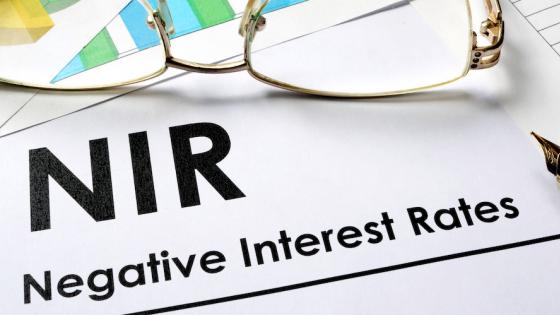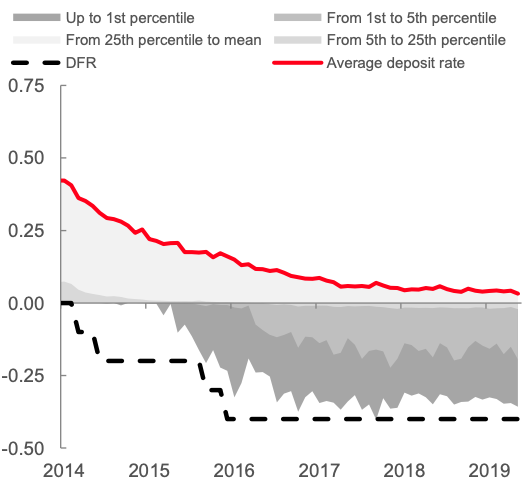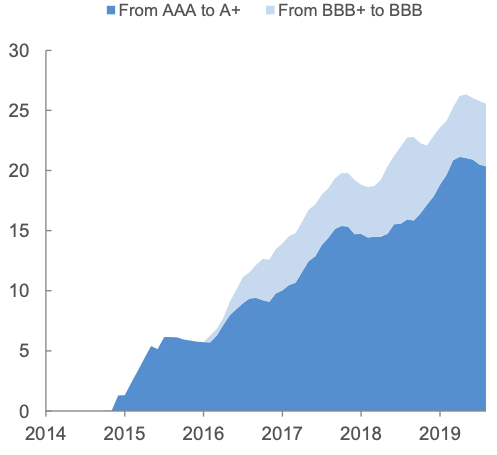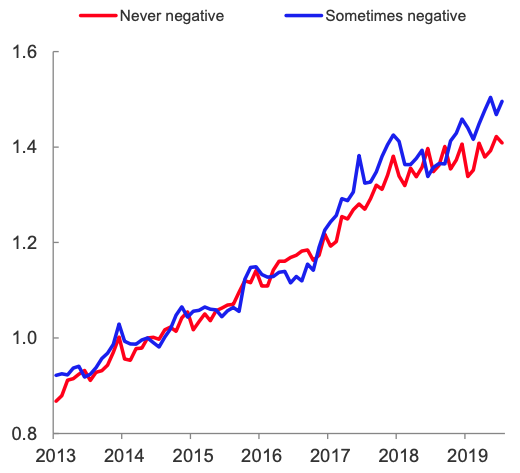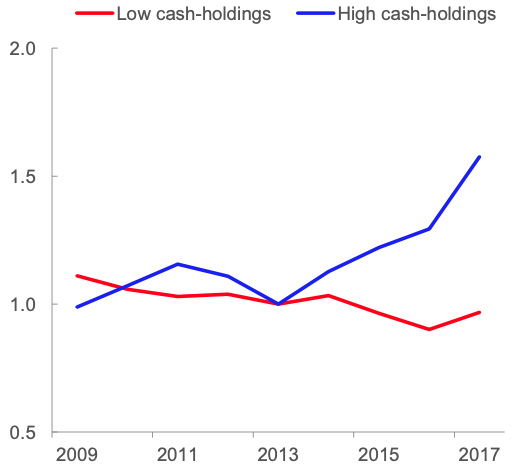Severe downturns normally require ample monetary policy accommodation through substantial policy interest rate cuts. During the last 40 years, central banks in industrialised countries – such as the Fed, the ECB, and the Bank of Japan – have usually cut rates by around 4% in response to recessions. However, with near zero interest rates prevailing in advanced economies, this would require moving the policy rates into the negative territory more frequently. Maintaining rates in positive territory would significantly limit the policy space that could be activated to stimulate the economy. Accordingly, with policy rates hitting the zero lower bound (ZLB), starting from 2012, central banks in Switzerland, Sweden, Denmark, Japan, and the euro area have moved their key policy rates below zero. Yet, there is no agreement in the economic profession on the effectiveness of negative interest rate policies (NIRPs).
Theoretically, there is uncertainty about the effectiveness of monetary policies below the ZLB. On the one hand, both in academic and policy circles, some argue that monetary policy becomes ineffective below the ZLB. Banks would not be able to lower interest rates on deposits, which in many jurisdictions represent their main source of funding, below zero, because market participants would rather hoard cash. Thus, when short-term interest rates approach zero, central banks would not be able to stimulate lending and demand by lowering short-term interest rates (see for example Keynes 1936, Krugman 1998, Eggertsson and Woodford 2003). Moreover, NIRPs could be contractionary because negative rates reduce banks’ profits and lead to a reduction in loan supply (Brunnemeier and Koby 2018, Eggertsson et al. 2019).1
On the other hand, Rogoff (2016, 2017), argues that the ZLB constraint should not be considered as a law of nature and negative rate policies can work pretty much as “central bank business as usual”. Lilley and Rogoff (2019), Agarwal and Kimball (2015), and Buiter and Panigirtzoglou (2003) also argue against the existence of disruptive effects of negative rates.
Ultimately, it is an empirical question whether the ZLB constitutes a black hole upending the laws of economics or can work pretty much as business as usual. Limited experience of NIRPs and data availability have so far prevented researchers from answering this question.
In our recent paper (Altavilla et al. 2019), we empirically evaluate whether the ZLB is a hard constraint. In doing so, our analysis concentrates on the consequences for banks and firms of breaking through the ZLB.
The 3 main results of our analysis are summarised below.
First, we document that negative policy interest rates do not hamper the transmission of monetary policy.
Using confidential data, we show that banks are able to transfer negative rates on to deposits. While a ZLB may be binding for household deposits – which, being relatively small, may be easily withdrawn and held as cash – corporations operating in the tax-compliant economy cannot conduct their operations without deposits as easily. Also, small firms – having fewer external financing alternatives – cannot risk jeopardising their bank relationships and access to credit by withdrawing when banks charge negative yields on their deposits. Figure 1 shows that banks in the euro area started to charge negative rates on corporate deposits after the ECB’s Deposit Facility Rate (DFR) became negative in June 2014. On average, interest rates became negative for around 5% of total deposits and around 20% of corporate deposits in the euro area as a whole. In Germany, deposits remunerated below zero account for 15% of total deposits and around 50% of enterprises’ deposits, indicating that the effects are economically relevant. However, the incidence of negative rate deposits is unevenly distributed over euro area banks. The ability to pass on negative rates is largely concentrated in solid banks. Figure 2 shows that the share of deposits charged with negative rates has being increasing during the NIRP period and is primarily driven by very highly rated banks.
Figure 1 Evolution of deposit rates for non-financial corporations (NFCs) (% per year)
Sources: Altavilla et al. (2019).
Notes: The composite indicator is computed by taking the weighted average of deposit rates on new overnight and agreed maturity deposits, where weights are outstanding amounts of these two categories. Rates on new deposits with agreed maturity are a weighted average of rates on new deposits for each maturity (below 1 year, between 1 and 2, above 2), where weights are the 24-month average of the new business volumes. Latest observation: August 2019.
Figure 2 Negative rate NFC deposits by rating (% of total NFC deposits)
Sources: Altavilla et al. (2019).
Notes: We report NFC deposits outstanding amounts of intermediaries that report charging negative rates as a share of total NFC deposits. We group intermediaries according to their average long-term debt rating across rating agencies (one month lag). Categories below investment grade are nil: no bank with ratings below investment grade has ever charged negative rates on deposits. Latest observation: August 2019.
Second, sound banks do not experience deposit outflows even if they offer negative rates (see Figure 3).
On average, deposits increase during the NIRP period, as is consistent with high demand for liquidity and safe assets. Deposits appear to increase to a somewhat larger extent in sound banks, which charge even more negative interest rates on new deposits during this period. In summary, the constraints typically associated with a ZLB arise only if agents lack confidence in the banking system.
Third, the analysis documents a novel corporate channel of monetary policy that is activated when rates are negative.
Firms that have relationships with banks that apply negative rates on deposits are more exposed to negative rates if they hold lots of cash. These firms increase their fixed investment and decrease their short-term assets and cash. Figure 4 shows the investment patterns of high and low cash-holdings firms that are associated with negative rate banks. In particular, we plot the investment of firms with cash-holdings in the top and the bottom decile. It is evident that differences in investment behaviour emerge only after the start of the NIRP and become more accentuated over time, broadly consistent with the timing of the changes in the interest rates on corporate deposits.
Figure 3 NFC deposits of banks that never charge negative deposit rates as opposed to banks that do offer negative deposit rates (deposit volume relative to level in May 2014)
Sources: Altavilla et al. (2019).
Notes: Deposits of banks whose average deposit rate on outstanding amounts on NFC deposits has never been negative (red line) as opposed to deposits of banks whose average NFC deposit rate has been negative at least once (blue line). Volumes for the two categories are normalised to 1 in May 2014. Latest observation: August 2019.
Figure 4 Corporate investment before and after the NIRP for exposed firms with low and high liquidity (investment relative to level in 2013)
Sources: Altavilla et al. (2019).
Notes: Average investment for corporate clients of banks whose average NFC deposit rate has been negative at least once, distinguishing between firms with a ratio of current assets over total assets in the top decile (high liquidity, blue line) and in the bottom decile (low liquidity, red line) of the distribution. Investment orthogonal to firm and year fixed effects, normalised to 1 in 2013. Latest observation: August 2019 for bank data, 2017 for firm data.
In summary, not only do sound banks pass the negative rates on to corporate depositors and maintain loan supply, but the transmission mechanism is enhanced by the fact that firms with large cash-holdings more exposed to negative rates decrease their liquid asset holdings and invest more in fixed assets.
The beneficial effects of NIRP on investment that we uncover can explain why negative rates do not appear to adversely affect bank profitability in existing studies (Altavilla et al. 2018, Lopez et al. 2018). Thus, in contrast to conventional wisdom, we find that, when banks are sound, the NIRP can provide stimulus to the real economy by influencing the behaviour of both banks and firms.
Authors’ note: The views expressed are those of the authors and do not necessarily reflect the views of the ECB or the Eurosystem.
References
Altavilla, C, L Burlon, M Giannetti, and S Holton (2019), “Is there a zero lower bound? The effects of negative policy rates on banks and firms”, Working Paper Series 2289, European Central Bank.
Altavilla, C, M Boucinha, J-L Peydro (2018), “Monetary policy and bank profitability in a low interest rate environment”, Economic Policy, October, 533-583.
Agarwal, R, and M Kimball (2015), “Breaking through the Zero Lower Bound”, International Monetary Fund Working Paper no. 15/224.
Brunnermeier, M K, and Y Koby (2016), “The reversal interest rate: An effective lower bound on monetary policy”, Working Paper, Princeton University.
Correia, I, E Farhi, J-P Nicolini, and P Teles (2013), “Unconventional Fiscal Policy at the Zero Bound”, American Economic Review, 103, 1172–1211.
Eggertsson, G B, and M Woodford (2003), “The Zero Bound on Interest Rates and Optimal Monetary Policy”, Brookings Papers on Economic Activity, 139–211.
Eggertsson, G B, R E Juelsrud, and E G Wold (2017), “Are negative nominal interest rates expansionary?”, NBER Working Paper no. 24039.
Eggertsson, G B, R E Juelsrud, L H Summers, and E G Wold (2019), “Negative Nominal Interest Rates and the Bank Lending Channel”, NBER Working Paper no. 25416.
Keynes, J M (1936), The General Theory of Employment, Interest, and Money, Macmillan.
Lopez, J A, A K Rose, and M Spiegel (2018), “Why Have Negative Nominal Interest Rates Had Such a Small Effect on Bank Performance? Cross Country Evidence”, NBER Working Paper no. 25004.
Rogoff, K (2016), The Curse of Cash, Princeton University Press.
Rogoff, K (2017), “Dealing with Monetary Paralysis at the Zero Bound”, Journal of Economic Perspectives, 31, 47–66.
Summers, L H (2014), “U.S. Economic Prospects: Secular Stagnation, Hysteresis, and the Zero Lower Bound”, Business Economics, 49, 65–73.
Endnotes
[1] The Governor of the Bank of England uses similar arguments in a speech criticizing NIRPs. See “Redeeming an unforgiving world”, 8th Annual Institute of International Finance G20 conference, Shanghai Friday 26 February 2016.
